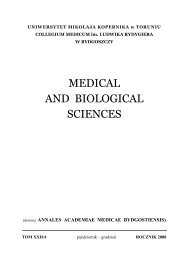Wsparcie spoÅeczne u chorych z miażdżycÄ tÄtnic koÅczyn dolnych
Wsparcie spoÅeczne u chorych z miażdżycÄ tÄtnic koÅczyn dolnych
Wsparcie spoÅeczne u chorych z miażdżycÄ tÄtnic koÅczyn dolnych
You also want an ePaper? Increase the reach of your titles
YUMPU automatically turns print PDFs into web optimized ePapers that Google loves.
38<br />
Zuzanna Piekorz et al.<br />
evaluation via survey. A successful verification of the<br />
majority of posed hypotheses ought to be treated as a<br />
confirmation of relevance of further studies in this<br />
area. Procured results may be utilized in preliminary<br />
evaluation of the problem and they can form a<br />
teajectory for further studies with expected equally<br />
successful result, which should be widely spread and<br />
included in treatment and prophylactic. Those<br />
presently presented allowed formulation of the<br />
following conclusions.<br />
CONCLUSIONS<br />
1. Confirmed in the study decrease in readings of<br />
arterial pressure and pulse attests to a positive effect of<br />
hatha yoga training on the circulatory system, and<br />
aforementioned changes in the parameters of subjects<br />
with high readings of arterial pressure justify executing<br />
yoga exercise in order to gain hypotensive effect.<br />
2. A positive influence of hatha yoga training on<br />
the organism is confirmed by subjective perception of<br />
the subjects in the scope of physical and mental<br />
comfort, which can result in improving the quality of<br />
life and reducing stress, and furthermore, it can<br />
intensify hypotensive effect and constitute a<br />
prophylactic for cardio-vascular diseases.<br />
3. Objectively read arterial pressure, contrasting<br />
with the knowledge and perception of its value in<br />
subjects, justifies the need for its regular reading and<br />
improving society's awareness concerning prophylactic<br />
of hypertension.<br />
4. The lack of influence of time span of<br />
practicing yoga and the frequency of training on the<br />
changes in values of arterial pressure and pulse<br />
occurring after session, attests to the possibility of<br />
selective and irregular utilizing elements of this<br />
method during sessions, which aim at gaining<br />
hypotensive effects.<br />
5. A domination of female participants, higher<br />
education and white collar professions in subjects may<br />
prove the upper classes' higher awareness of the health<br />
advantages of hatha yoga training and justify the<br />
necessity of its propagation among the remaining part<br />
of the society.<br />
BIBLIOGRAPHY<br />
1. Kriyananda S.: Radża joga. Sztuka i nauka.<br />
Wydawnictwo Kos, Katowice 2007<br />
2. Monro R., Nagarathna R., Nagendra H.R.: Joga w<br />
pospolitych dolegliwościach. Wydawnictwo Delta.<br />
Warszawa 2002<br />
3. Kulmatycki L.: Wpływ treningu relaksacyjnego jogi na<br />
obniżenie ciśnienia tętniczego. Postępy Rehabilitacji,<br />
1993, 7/4, 55-60<br />
4. Dziadkiewicz M.: Trening antystresowy łączący sesję<br />
asan hatha jogi oraz elementy pracy z umysłem. Stres i<br />
jego modelowanie. Pod. Red. Szopa J., Harciarek M.<br />
WWZPCz, Częstochowa 2004, 156-167<br />
5. Grabara M., Juszczyk E., Szopa J.: Hatha yoga exercises<br />
in prevention and correction of body posture defects at<br />
children in school age. 5 th Interational Conference<br />
Movement and Health, Głuchołazy 2006, Proceedings,<br />
Opole University of Technology, Opole 2006, 418-427<br />
6. Grabara M., Szopa J.: Hatha yoga influence on<br />
practitioners health state. 5 th Interational Conference<br />
Movement and Health, Głuchołazy 2006, Proceedings,<br />
Opole University of Technology, Opole 2006, 235-241<br />
7. Szopa J.: Lecznicze i fizjologiczne działanie Yogasanas.<br />
Zeszyty Naukowe Wyższej Szkoły Zarządzania w<br />
Częstochowie, 2000, 1, 47-49<br />
8. Szopa J.: Podstawowe pojęcia klasycznej jogi indyjskiej.<br />
Niepokoje i nadzieje współczesnego człowieka.<br />
Człowiek w sytuacji przełomu. Pod. Red. Derbis R.<br />
Wydawnictwo WSP, Częstochowa 2003, 259-262<br />
9. Szopa J.: Podstawowe zagadnienia związane z<br />
technikami relaksacyjnymi. Stres i jego modelowanie.<br />
Pod. Red. Szopa J., Harciarek M. WWZPCz,<br />
Częstochowa 2004, 16-18<br />
10. Szopa J.: Rola jogi indyjskiej w rozwoju<br />
psychofizycznym polskiego społeczeństwa. Portal<br />
www.jogaakademicka.pl, 16.04.2011<br />
11. Eliade M.: Patańdżali i joga. Wydawnictwo Pegaz,<br />
Warszawa 1994<br />
12. Iyengar B.K.S.: Joga. Państwowe Wydawnictwo<br />
Naukowe, Warszawa 1990<br />
13. Iyengar G.S.: Joga. Doskonała dla kobiet. Wydawnictwo<br />
Virya, Warszawa 1996<br />
14. Malczyk E.: Joga – gimnastyka czy filozofia? Za co<br />
Zachód pokochał jogę. Portal www.joga-joga,<br />
12.02.2011<br />
15. Scott J.: Joga Ashtanga. Wydawnictwo Delta, Warszawa<br />
2003<br />
16. Szyszko-Bohusz A.: Joga – indyjski system filozoficzny,<br />
leczniczy i pedagogiczny. Polska Akademia Nauk,<br />
Kraków 1978.<br />
17. Halawa B.: Niefarmakologiczne leczenie ciśnienia<br />
tętniczego. Polski Merkuriusz Lekarski, 1997, 3/14, 89-<br />
91<br />
18. Halawa B., Mazurek W.: Zmiana stylu życia w<br />
zapobieganiu i leczeniu nadciśnienia tętniczego.<br />
Advances in Clinical and Experimental Medicine, 2004,<br />
13/5A, 67-71<br />
19. Wexler R., Aukerman G.: Niefarmakologiczne strategie<br />
postępowania z nadciśnieniem tętniczym. Lekarz<br />
Rodzinny, 2007, 12/5, 482-486<br />
20. Irzmański R., Barylski M., Banach M., Piechota M.,<br />
Serwa-Stępień E., Okoński P., Kowalski J., Pawlicki L.:

















